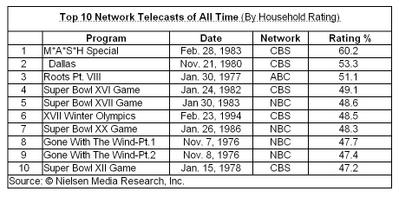Although I haven’t put together the numbers, I would venture that not one network owner would break into the top 10 even if we added together all their corporate-owned programming-- i.e., broadcast and cable networks -- available at any given hour.

Other data I’ve presented shows that the five largest providers of television programming networks (Viacom, Disney, NBC, Time Warner and News Corp) account for a smaller proportion of television viewership than only three owners of three networks regularly aggregated in the 1960s into the 1980s. This undercuts the notion that fewer owners are controlling what more of us choose to watch, certainly if the comparison point is some supposed “Golden Age” of television a decade or more in the past.
But it is possible that if today’s media companies simply try to circle the wagons their future is not guaranteed. I recently was leading graduate students in a Strategic Planning class on a case study (by purchase) of Wal-Mart. Here’s a sobering lesson from that case:
“Of the top 10 discounters operating in 1962 – the year Wal*Mart opened for business—not one remained in 1993.”
Korvette’s, W.T. Grant, Woolco, Zayre, Two Guys, among others had been at the top and were gone. More recently, established chains such as Bradlees, Caldor and
We shouldn’t expect to see media companies—no matter how large or seemingly entrenched—stand pat as the technologies change around them, as consumer behavior adjusts to the choices and broader range of technologies available, and as advertisers follow their customers.
No comments:
Post a Comment